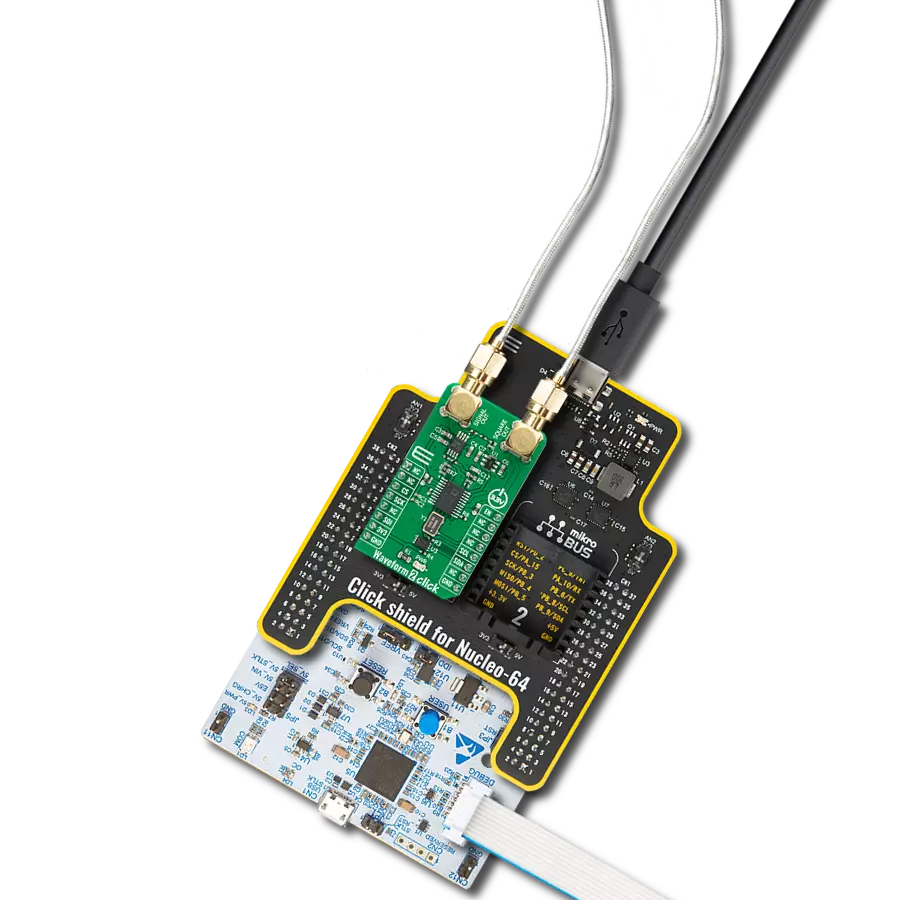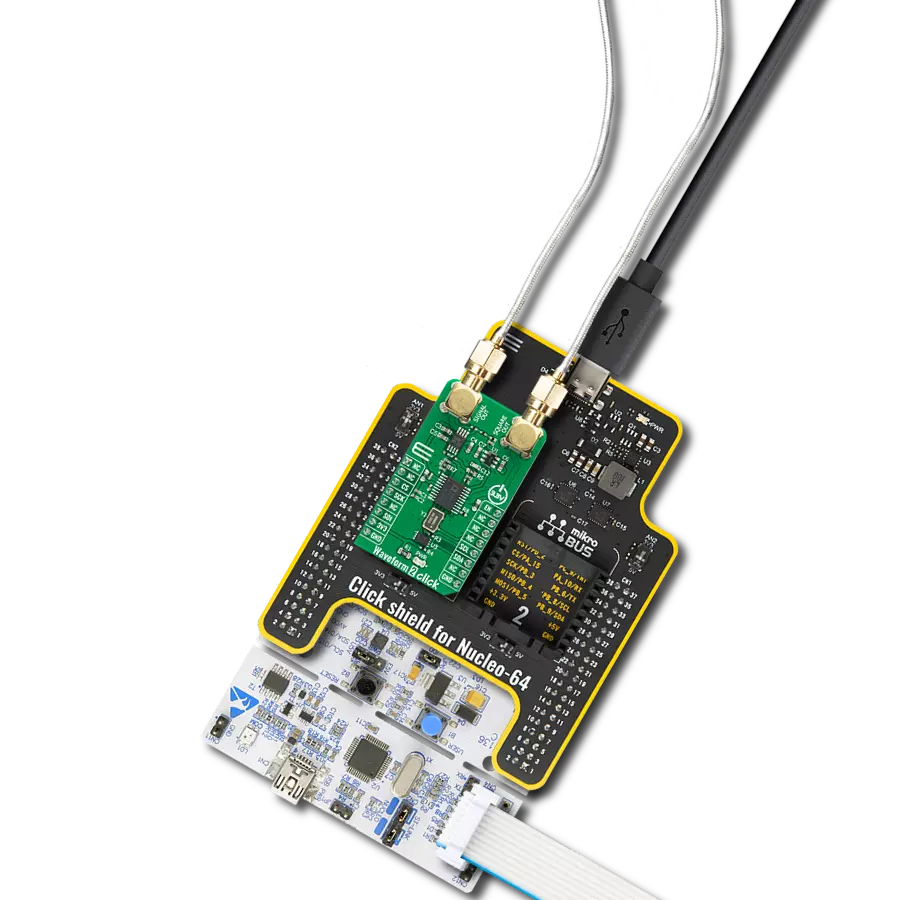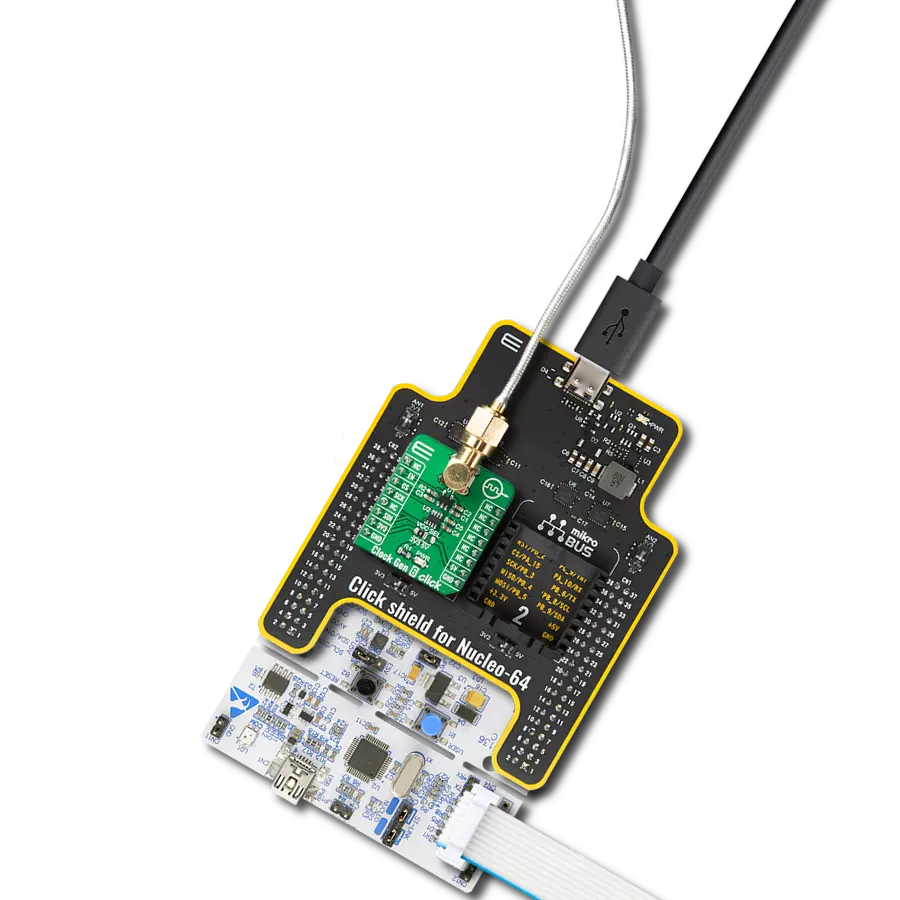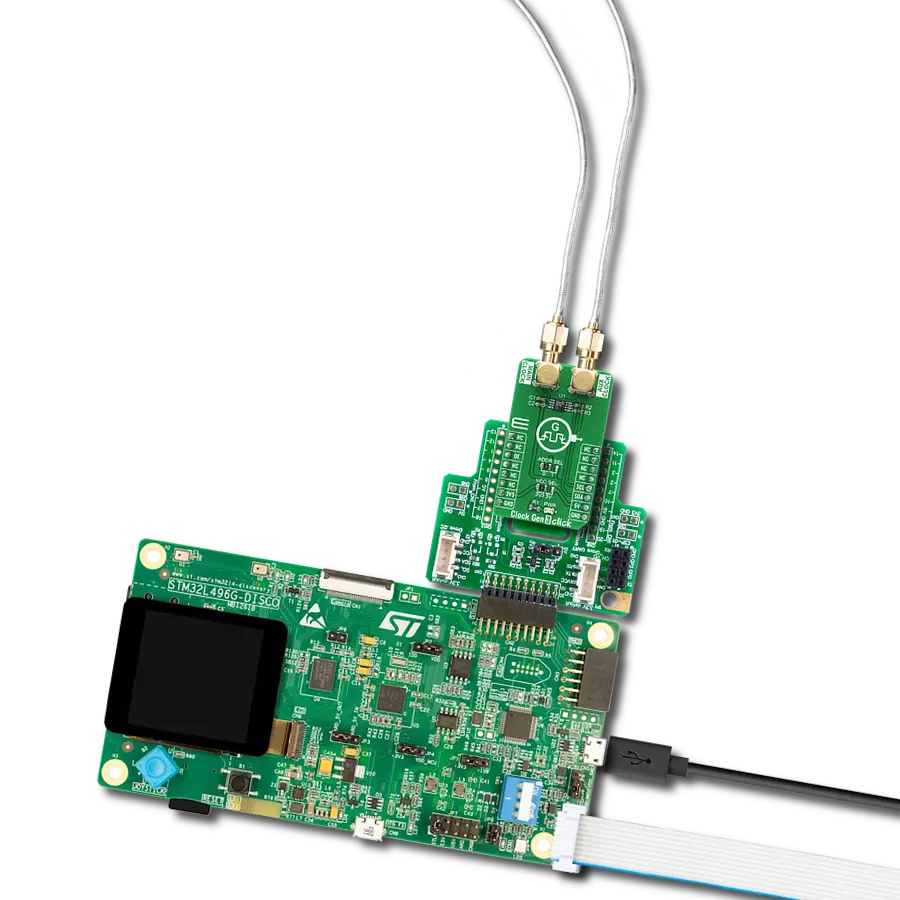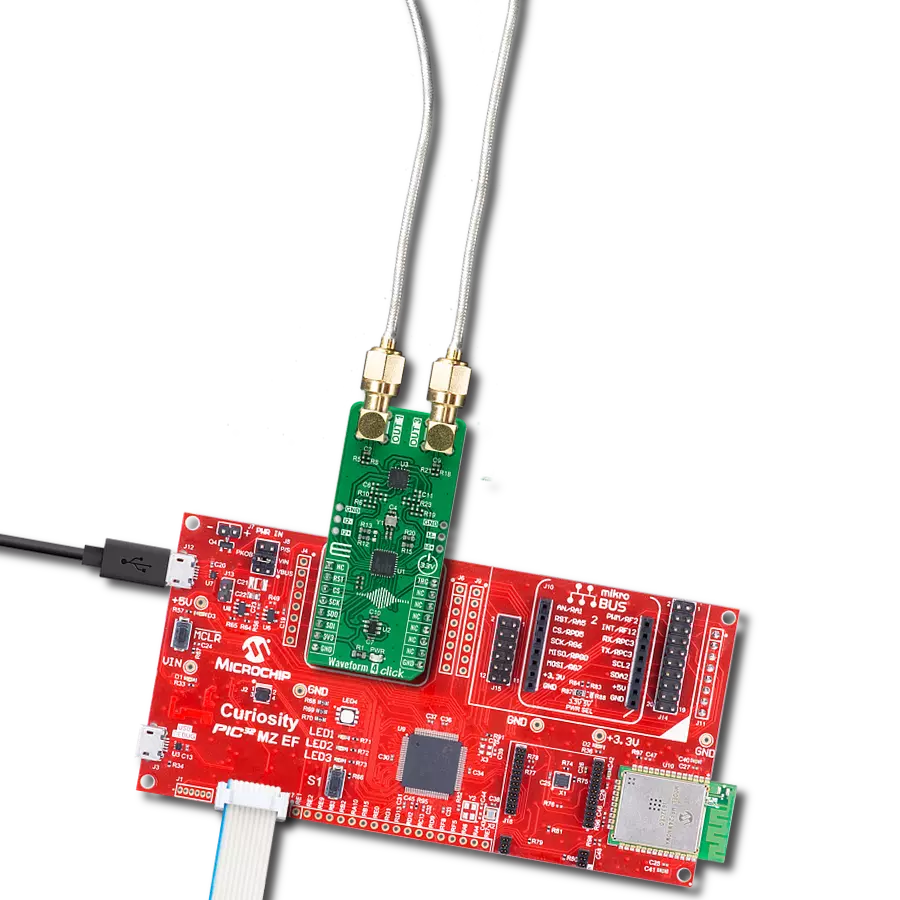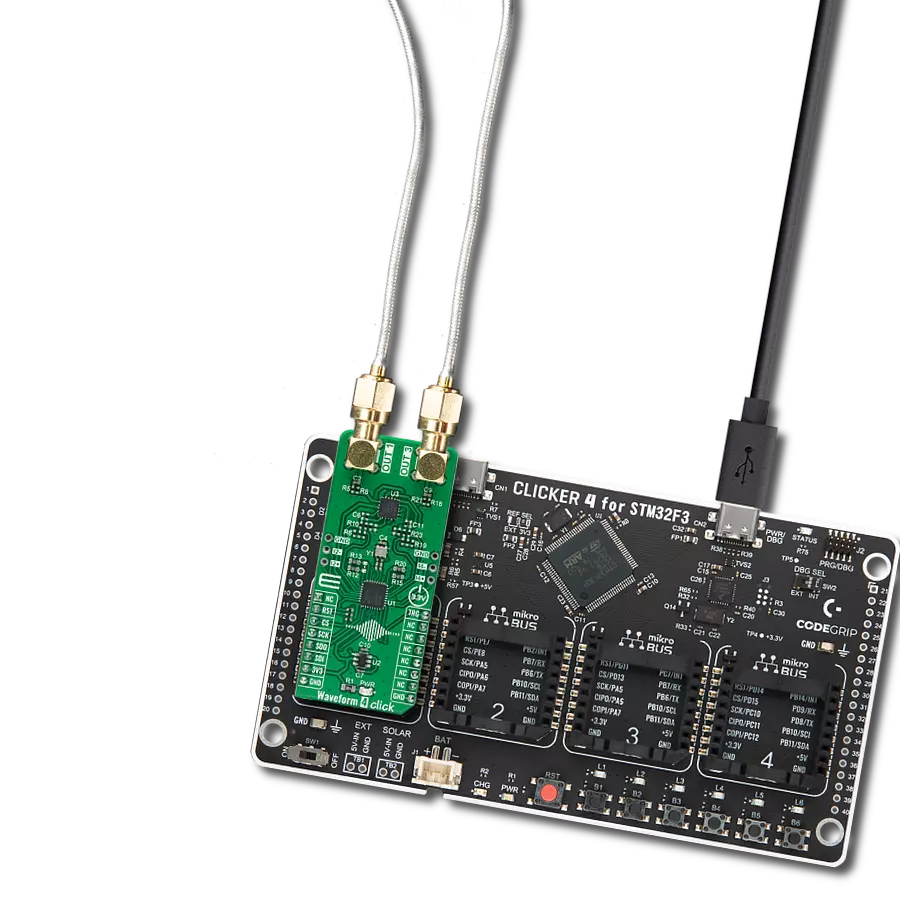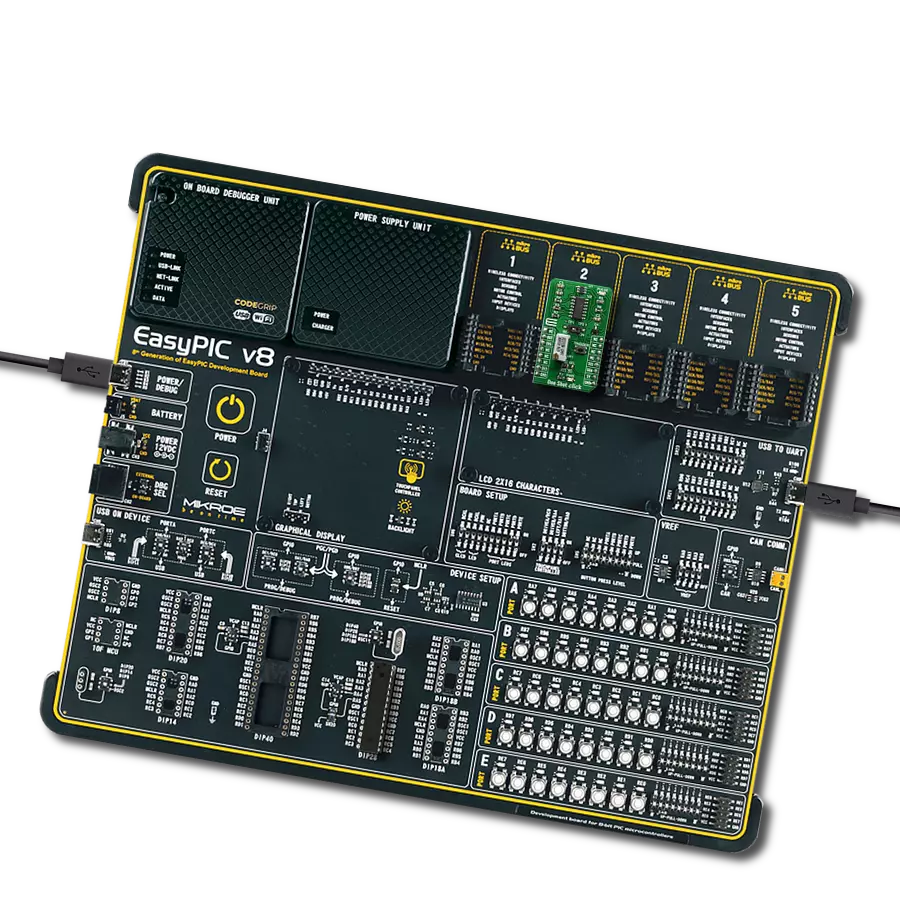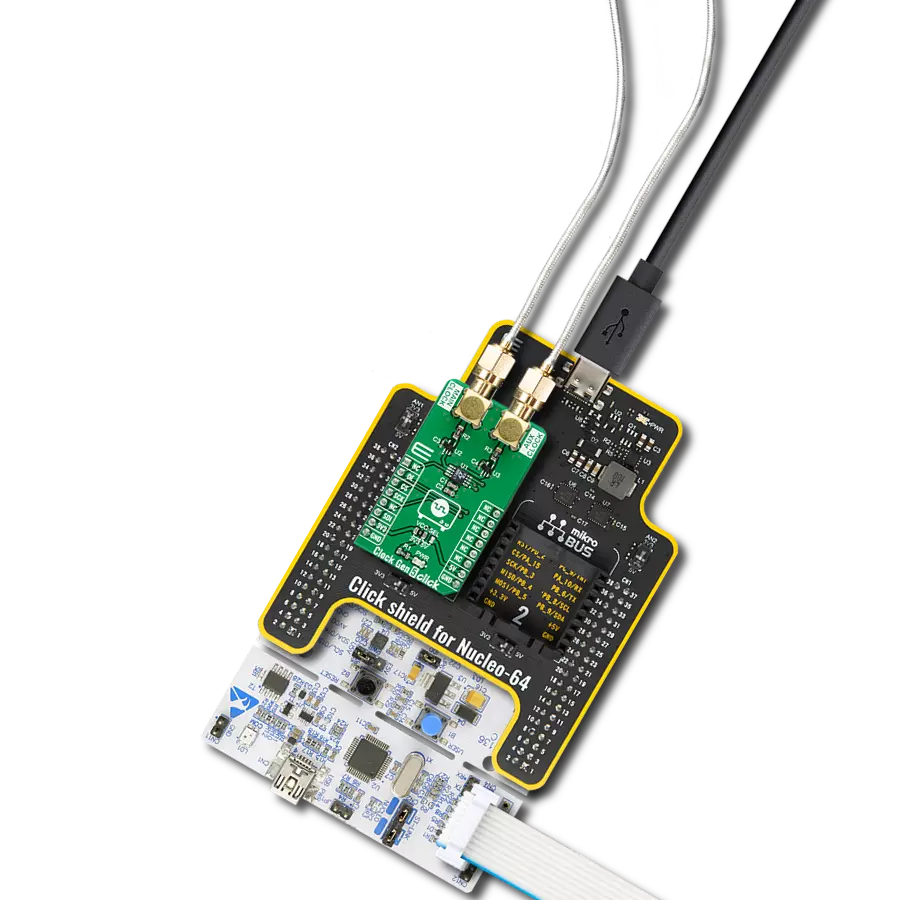Unleash the boundless possibilities of this high-performance time-to-digital converter today
A
A
Hardware Overview
How does it work?
TDC 2 Click is based on the AS6500, a high-resolution time-to-digital converter from ScioSense, featuring CMOS inputs, high measurement performance, and high data throughput. The AS6500 can measure time intervals as low as 5ns with 10ps resolution on all four STOP channels at a sampling rate of up to 1.5Ms/s. It is characterized by high configuration flexibility, a wide measurement range from 0 to 16s, and simple data post-processing thanks to calibrated results. It calculates calibrated stop measurements referenced to the applied reference clock. This Click board™ is ideal for optical applications, including general-purpose laser distance measurement in 1D, 2D, and 3D, speed control, object recognition, time-of-flight spectroscopy, and many more. The positive edges of the stop signals, applied on the STOP terminals (1-4), are measured versus the preceding reference clock edge. The reference clock can be brought externally via the CLR
pin on the middle header terminal or from the onboard 8MHz quartz oscillator. This feature is selectable through software – register-setting. The reference clock represents the framework for all time measurements and serves as a universal time base. The TDC measures the clock pulses continuously as a time reference point for STOP pulses and an internal reference period. The measurement of the STOP events always refers to the preceding reference clock. The reference clock is counted continuously, and the actual count is assigned as a reference index to a STOP pulse. TDC 2 Click communicates with the host MCU through a standard SPI interface to read data and configure the frontend, supporting high clock speed up to 50MHz and the most common SPI mode, SPI Mode 1. SPI pins also use an interrupt pin that indicates to the host MCU that data are available and ready for processing. The AS6500 uses several more signals available on the
mikroBUS™ socket for successful time measurements. With the RIR pin, the internal counter for the reference index is set back to zero, simplifying the overview of the reference index in the output data stream. Next, setting the disable pin, marked as DIS, to a high logic state, the measurements on all four stops are disabled. On the other hand, the reference clock is not affected, and internal reference measurements are continued. Apart from the mikroBUS™ socket, these signals can also be found on the middle header, grouped with the reference clock pin. This Click board™ can only be operated with a 3.3V logic voltage level. The board must perform appropriate logic voltage level conversion before using MCUs with different logic levels. However, the Click board™ comes equipped with a library containing functions and an example code that can be used as a reference for further development.
Features overview
Development board
Nucleo-64 with STM32F091RC MCU offers a cost-effective and adaptable platform for developers to explore new ideas and prototype their designs. This board harnesses the versatility of the STM32 microcontroller, enabling users to select the optimal balance of performance and power consumption for their projects. It accommodates the STM32 microcontroller in the LQFP64 package and includes essential components such as a user LED, which doubles as an ARDUINO® signal, alongside user and reset push-buttons, and a 32.768kHz crystal oscillator for precise timing operations. Designed with expansion and flexibility in mind, the Nucleo-64 board features an ARDUINO® Uno V3 expansion connector and ST morpho extension pin
headers, granting complete access to the STM32's I/Os for comprehensive project integration. Power supply options are adaptable, supporting ST-LINK USB VBUS or external power sources, ensuring adaptability in various development environments. The board also has an on-board ST-LINK debugger/programmer with USB re-enumeration capability, simplifying the programming and debugging process. Moreover, the board is designed to simplify advanced development with its external SMPS for efficient Vcore logic supply, support for USB Device full speed or USB SNK/UFP full speed, and built-in cryptographic features, enhancing both the power efficiency and security of projects. Additional connectivity is
provided through dedicated connectors for external SMPS experimentation, a USB connector for the ST-LINK, and a MIPI® debug connector, expanding the possibilities for hardware interfacing and experimentation. Developers will find extensive support through comprehensive free software libraries and examples, courtesy of the STM32Cube MCU Package. This, combined with compatibility with a wide array of Integrated Development Environments (IDEs), including IAR Embedded Workbench®, MDK-ARM, and STM32CubeIDE, ensures a smooth and efficient development experience, allowing users to fully leverage the capabilities of the Nucleo-64 board in their projects.
Microcontroller Overview
MCU Card / MCU
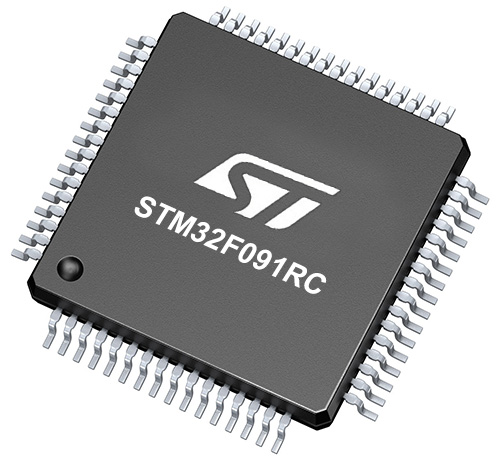
Architecture
ARM Cortex-M0
MCU Memory (KB)
256
Silicon Vendor
STMicroelectronics
Pin count
64
RAM (Bytes)
32768
You complete me!
Accessories
Click Shield for Nucleo-64 comes equipped with two proprietary mikroBUS™ sockets, allowing all the Click board™ devices to be interfaced with the STM32 Nucleo-64 board with no effort. This way, Mikroe allows its users to add any functionality from our ever-growing range of Click boards™, such as WiFi, GSM, GPS, Bluetooth, ZigBee, environmental sensors, LEDs, speech recognition, motor control, movement sensors, and many more. More than 1537 Click boards™, which can be stacked and integrated, are at your disposal. The STM32 Nucleo-64 boards are based on the microcontrollers in 64-pin packages, a 32-bit MCU with an ARM Cortex M4 processor operating at 84MHz, 512Kb Flash, and 96KB SRAM, divided into two regions where the top section represents the ST-Link/V2 debugger and programmer while the bottom section of the board is an actual development board. These boards are controlled and powered conveniently through a USB connection to program and efficiently debug the Nucleo-64 board out of the box, with an additional USB cable connected to the USB mini port on the board. Most of the STM32 microcontroller pins are brought to the IO pins on the left and right edge of the board, which are then connected to two existing mikroBUS™ sockets. This Click Shield also has several switches that perform functions such as selecting the logic levels of analog signals on mikroBUS™ sockets and selecting logic voltage levels of the mikroBUS™ sockets themselves. Besides, the user is offered the possibility of using any Click board™ with the help of existing bidirectional level-shifting voltage translators, regardless of whether the Click board™ operates at a 3.3V or 5V logic voltage level. Once you connect the STM32 Nucleo-64 board with our Click Shield for Nucleo-64, you can access hundreds of Click boards™, working with 3.3V or 5V logic voltage levels.
Used MCU Pins
mikroBUS™ mapper
Take a closer look
Click board™ Schematic

Step by step
Project assembly
Track your results in real time
Application Output
1. Application Output - In Debug mode, the 'Application Output' window enables real-time data monitoring, offering direct insight into execution results. Ensure proper data display by configuring the environment correctly using the provided tutorial.

2. UART Terminal - Use the UART Terminal to monitor data transmission via a USB to UART converter, allowing direct communication between the Click board™ and your development system. Configure the baud rate and other serial settings according to your project's requirements to ensure proper functionality. For step-by-step setup instructions, refer to the provided tutorial.

3. Plot Output - The Plot feature offers a powerful way to visualize real-time sensor data, enabling trend analysis, debugging, and comparison of multiple data points. To set it up correctly, follow the provided tutorial, which includes a step-by-step example of using the Plot feature to display Click board™ readings. To use the Plot feature in your code, use the function: plot(*insert_graph_name*, variable_name);. This is a general format, and it is up to the user to replace 'insert_graph_name' with the actual graph name and 'variable_name' with the parameter to be displayed.

Software Support
Library Description
This library contains API for TDC 2 Click driver.
Key functions:
tdc2_read_resultsTDC 2 results data reading function.tdc2_start_measuringTDC 2 start measuring function.tdc2_set_resolutionTDC 2 set resolution function.
Open Source
Code example
The complete application code and a ready-to-use project are available through the NECTO Studio Package Manager for direct installation in the NECTO Studio. The application code can also be found on the MIKROE GitHub account.
/*!
* @file main.c
* @brief TDC 2 Click example
*
* # Description
* This library contains API for TDC 2 Click driver.
* The library initializes and defines the SPI bus drivers to
* write and read data from registers, as well as the default
* configuration for a reading time between two STOP signals.
*
* The demo application is composed of two sections :
*
* ## Application Init
* Initializes the driver after that resets the device and
* performs default configuration and sets the device in read mode.
*
* ## Application Task
* This example demonstrates the use of the TDC 2 Click board by
* measuring the time between two STOP signals. This example is set up to
* generate stop signals until FIFO fil's up which is indicated by interrupt pin going to low state.
* After that FIFO buffer is completely emptied by reading, and that data is used to calculate
* the time between STOP signals.
*
* @note
* In order to test this example, you will need to connect STOP1 with the DIS pin. Disable pin is
* disabled by software and it isn't going to affect the working state of the TDC 2 Click Bord.
*
* @author Stefan Ilic
*
*/
#include "board.h"
#include "log.h"
#include "tdc2.h"
static tdc2_t tdc2;
static log_t logger;
/**
* @brief Dev generate stop signal function.
* @details This function generates the stop signal by toggling DIS pin.
* @param[out] cfg : Click configuration structure.
* See #tdc2_cfg_t object definition for detailed explanation.
* @return Nothing.
* @note DIS pin ( Disable STOP channels) is disabled by software and isn't affecting the example.
*/
void dev_generate_stop( tdc2_t *ctx );
void application_init ( void )
{
log_cfg_t log_cfg; /**< Logger config object. */
tdc2_cfg_t tdc2_cfg; /**< Click config object. */
/**
* Logger initialization.
* Default baud rate: 115200
* Default log level: LOG_LEVEL_DEBUG
* @note If USB_UART_RX and USB_UART_TX
* are defined as HAL_PIN_NC, you will
* need to define them manually for log to work.
* See @b LOG_MAP_USB_UART macro definition for detailed explanation.
*/
LOG_MAP_USB_UART( log_cfg );
log_init( &logger, &log_cfg );
log_info( &logger, " Application Init " );
// Click initialization.
tdc2_cfg_setup( &tdc2_cfg );
TDC2_MAP_MIKROBUS( tdc2_cfg, MIKROBUS_1 );
if ( SPI_MASTER_ERROR == tdc2_init( &tdc2, &tdc2_cfg ) )
{
log_error( &logger, " Communication init." );
for ( ; ; );
}
if ( TDC2_ERROR == tdc2_default_cfg ( &tdc2 ) )
{
log_error( &logger, " Default configuration." );
for ( ; ; );
}
tdc2_start_measuring ( &tdc2 );
log_info( &logger, " Application Task " );
}
void application_task ( void )
{
uint32_t reference_index [ 18 ] = { 0 };
uint32_t stop_result [ 18 ] = { 0 };
uint8_t cnt = 0;
tdc2_reset_index( &tdc2 );
Delay_ms ( 10 );
while ( tdc2_get_int_state( &tdc2 ) == 1 )
{
dev_generate_stop( &tdc2 );
Delay_ms ( 100 );
}
while ( tdc2_get_int_state( &tdc2 ) == 0 )
{
tdc2_read_results( &tdc2, TDC2_REG_INDEX_CH1_BYTE3, &reference_index[ cnt ], &stop_result[ cnt ] );
log_printf( &logger, "CH1: Reference Index[%d]: %lu, Stop Result[%d]: %lu \r\n", ( uint16_t ) cnt,
reference_index[ cnt ], ( uint16_t ) cnt, stop_result[ cnt ] );
Delay_ms ( 10 );
if ( cnt )
{
uint32_t time = 0;
tdc2_get_time_between_stops ( &tdc2, stop_result[ cnt - 1 ], reference_index[ cnt - 1 ],
stop_result[ cnt ], reference_index[ cnt ], &time );
log_printf( &logger, "Time between STOP %d and STOP %d is %lu ms \r\n",
( uint16_t ) ( cnt - 1 ), ( uint16_t ) cnt, time / TDC2_uS_TO_mS );
Delay_ms ( 10 );
}
cnt++;
}
log_printf( &logger, "---------------------------------------------- \r\n" );
}
int main ( void )
{
/* Do not remove this line or clock might not be set correctly. */
#ifdef PREINIT_SUPPORTED
preinit();
#endif
application_init( );
for ( ; ; )
{
application_task( );
}
return 0;
}
void dev_generate_stop( tdc2_t *ctx )
{
digital_out_high( &ctx->dis );
Delay_ms ( 1 );
digital_out_low( &ctx->dis );
}
// ------------------------------------------------------------------------ END
Additional Support
Resources
Category:Clock generator



















